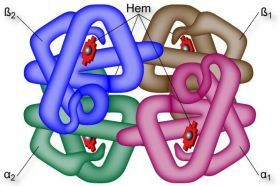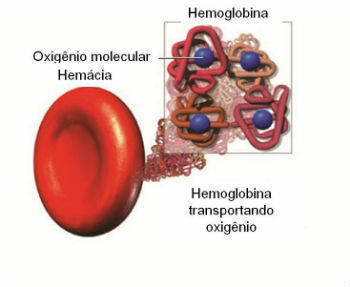Hemoglobin (Hb) is a protein found inside erythrocytes or red blood cells.
Its main function is carry oxygen from the lungs to all tissues in the body. At the same time, too carries some of the carbon dioxide from the tissues to the lungs.
It is hemoglobin that gives red blood cells their red color.
Red blood cells are red blood cells, made up of hemoglobins and globulins.
Structure and Composition
Hemoglobin is a protein with a quaternary structure.
It is composed of four globin chains (protein part) it is aheme group (prosthetic group) connected to each of them.
In adults, globin chains are of two types: two of the α-type (alpha) and two of the β-type (beta).
The heme group contains a iron atom central in its interior, kept in the ferrous state. Iron is responsible for oxygen uptake, since the mineral easily binds to oxygen.

Hemoglobin structure
Globin not only serves the structural function, but also makes the reversibility of the bond between iron and oxygen possible.
Types of Hemoglobin
Globin chains can be of types: alpha, beta, gamma, delta, epsilon, and zeta. They are produced at different stages of development.
So we have different different hemoglobin throughout life:
- Embryonic Hemoglobin
- fetal hemoglobin
- Hemoglobin in adults
Combinations between the different types of chains result in different hemoglobin molecules.
The best known abnormal hemoglobin is HbS – sickle (sickle, in Portuguese, due to its shape), responsible for sickle cell anemia.
There is still the glycated or glycated hemoglobin. It corresponds to the union of hemoglobin with the glucose present in the blood. Once turned on, glucose remains in hemoglobin throughout its lifetime, between two to three months.
Glycosylated hemoglobin is used for diagnosing and monitoring diabetes.
The more sugar in the blood, the greater the chances that hemoglobin is glycosylated.
Also read about:
- Protein Structure
- Proteins
Gas transport
As we have seen, hemoglobin can bind to oxygen and/or carbon dioxide.
Oxygen transport (O2)
- The hemoglobin of red blood cells entering the lungs is bound to carbon dioxide;
- In the lungs, the concentration of oxygen is higher than that of carbon dioxide. Allied to this, hemoglobin has an affinity for oxygen. So it releases carbon dioxide and binds to oxygen.
One molecule of hemoglobin can combine with four molecules of oxygen gas. When hemoglobin binds to oxygen it is called oxyhemoglobin.

Oxygen transport through hemoglobin
Transport of carbon dioxide (CO2)
Transporting carbon dioxide is more complex. This is because it can be transported in three ways: dissolved in blood plasma (7%), bound to hemoglobin (23%) and in the form of bicarbonate ions dissolved in plasma (70%).
- Hemoglobin leaves the heart and reaches the muscles through the bloodstream;
- Due to metabolism, the concentration of carbon dioxide in muscle is high and the concentration of oxygen is low;
- Hemoglobin then binds to carbon dioxide and releases oxygen.
In this reaction, the carbamino-hemoglobin.
During exercise, muscle produces acids (hydrogen and lactic acid ions) that lower the pH than normal.
O acidic pH it decreases the attraction between oxygen and hemoglobin, causing more oxygen to be released than normal. This condition increases muscle oxygenation.
Transport of carbon monoxide (CO)
Hemoglobin has a high affinity for the Carbon monoxide (CO). When hemoglobin binds to carbon monoxide it is called carboxyhemoglobin.
The affinity for carbon monoxide is up to 23 times greater than for oxygen. However, this association can be lethal, carbon monoxide prevents the transport of oxygen to the body's tissues.
Learn more about Red Cells.
Diseases and Hemoglobin
Hemoglobin levels can be detected by blood tests.
The reference values for hemoglobin are:
- Children from 2 to 6 years old: 11.5 to 13.5 g/dL;
- Children from 6 to 12 years old: 11.5 to 15.5 g/dL;
- Men: 14 to 18 g/dL;
- Women: 12 to 16 g/dL;
- pregnant: 11 g/dL.
Differences in these values can indicate health problems:
low hemoglobin
- Anemia
- Lymphoma
- hypothyroidism
- Bleeding
- Renal insufficiency
high hemoglobin
- Dehydration
- Pulmonary emphysema
- kidney tumor
Hemoglobin in urine (haemoglobinuria) is detected by examination. This condition can be related to kidney problems such as infections, pyelonephritis or cancer.
Also read about:
Blood
Plasma

